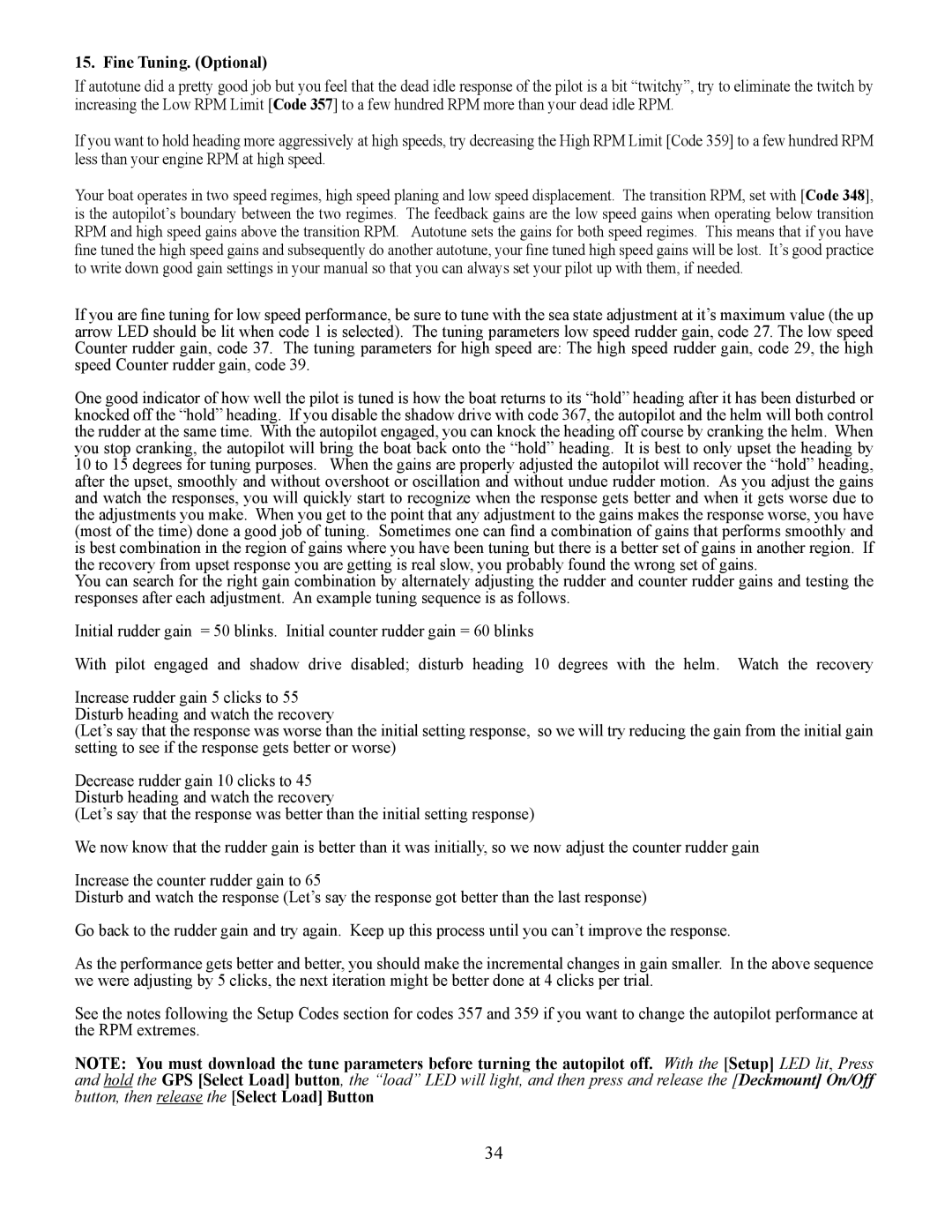15. Fine Tuning. (Optional)
If autotune did a pretty good job but you feel that the dead idle response of the pilot is a bit “twitchy”, try to eliminate the twitch by increasing the Low RPM Limit [Code 357] to a few hundred RPM more than your dead idle RPM.
If you want to hold heading more aggressively at high speeds, try decreasing the High RPM Limit [Code 359] to a few hundred RPM less than your engine RPM at high speed.
Your boat operates in two speed regimes, high speed planing and low speed displacement. The transition RPM, set with [Code 348], is the autopilot’s boundary between the two regimes. The feedback gains are the low speed gains when operating below transition RPM and high speed gains above the transition RPM. Autotune sets the gains for both speed regimes. This means that if you have fine tuned the high speed gains and subsequently do another autotune, your fine tuned high speed gains will be lost. It’s good practice to write down good gain settings in your manual so that you can always set your pilot up with them, if needed.
If you are fine tuning for low speed performance, be sure to tune with the sea state adjustment at it’s maximum value (the up arrow LED should be lit when code 1 is selected). The tuning parameters low speed rudder gain, code 27. The low speed Counter rudder gain, code 37. The tuning parameters for high speed are: The high speed rudder gain, code 29, the high speed Counter rudder gain, code 39.
One good indicator of how well the pilot is tuned is how the boat returns to its “hold” heading after it has been disturbed or knocked off the “hold” heading. If you disable the shadow drive with code 367, the autopilot and the helm will both control the rudder at the same time. With the autopilot engaged, you can knock the heading off course by cranking the helm. When you stop cranking, the autopilot will bring the boat back onto the “hold” heading. It is best to only upset the heading by 10 to 15 degrees for tuning purposes. When the gains are properly adjusted the autopilot will recover the “hold” heading, after the upset, smoothly and without overshoot or oscillation and without undue rudder motion. As you adjust the gains and watch the responses, you will quickly start to recognize when the response gets better and when it gets worse due to the adjustments you make. When you get to the point that any adjustment to the gains makes the response worse, you have (most of the time) done a good job of tuning. Sometimes one can find a combination of gains that performs smoothly and is best combination in the region of gains where you have been tuning but there is a better set of gains in another region. If the recovery from upset response you are getting is real slow, you probably found the wrong set of gains.
You can search for the right gain combination by alternately adjusting the rudder and counter rudder gains and testing the responses after each adjustment. An example tuning sequence is as follows.
Initial rudder gain = 50 blinks. Initial counter rudder gain = 60 blinks
With pilot engaged and shadow drive disabled; disturb heading 10 degrees with the helm. Watch the recovery
Increase rudder gain 5 clicks to 55 Disturb heading and watch the recovery
(Let’s say that the response was worse than the initial setting response, so we will try reducing the gain from the initial gain setting to see if the response gets better or worse)
Decrease rudder gain 10 clicks to 45 Disturb heading and watch the recovery
(Let’s say that the response was better than the initial setting response)
We now know that the rudder gain is better than it was initially, so we now adjust the counter rudder gain
Increase the counter rudder gain to 65
Disturb and watch the response (Let’s say the response got better than the last response)
Go back to the rudder gain and try again. Keep up this process until you can’t improve the response.
As the performance gets better and better, you should make the incremental changes in gain smaller. In the above sequence we were adjusting by 5 clicks, the next iteration might be better done at 4 clicks per trial.
See the notes following the Setup Codes section for codes 357 and 359 if you want to change the autopilot performance at the RPM extremes.
NOTE: You must download the tune parameters before turning the autopilot off. With the [Setup] LED lit, Press and hold the GPS [Select Load] button, the “load” LED will light, and then press and release the [Deckmount] On/Off button, then release the [Select Load] Button
34
